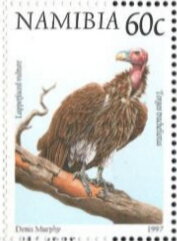Stamp: Lappet-faced Vulture (Aegypius tracheliotus) (Namibia 1998)
Lappet-faced Vulture (Aegypius tracheliotus) (Namibia 1998)
13 January (Namibia ) within release Flora and Fauna goes into circulation Stamp Lappet-faced Vulture (Aegypius tracheliotus) face value 60 Namibian cent
| Stamp Lappet-faced Vulture (Aegypius tracheliotus) in catalogues | |
|---|---|
| Michel: | Mi: NA 883C |
| Yvert et Tellier: | Yt: NA 826a |
| Stanley Gibbons: | Sg: NA 756a |
Stamp is square format.
Stamp from bookletAlso in the issue Flora and Fauna:
- Stamp - Blue-cheecked Bee-eater (Merops persicus) face value 40;
- Stamp - Bushman Poison (Adenium bochnianum) face value 10;
- Stamp - Camel's Foot (Bauhinia petersiana) face value 20;
- Stamp - Flame Lily (Gloriosa superba) face value 5;
- Stamp - Lappet-faced Vulture (Aegypius tracheliotus) face value 60;
- Stamp - Laughing Dove (Streptopelia senegalensis) face value 50;
- Stamp - Leopard (Panthera pardus) face value Postcard;
- Stamp - Rosy-faced Lovebird (Agapornis roseicollis) face value Standard;
- Stamp - Southern Yellow-billed Hornbill (Tockus flavirostris) face value 90;
- Stamp - Western Rhigozum (Rhigozum brevispinosum) face value 30;
Stamp Lappet-faced Vulture (Aegypius tracheliotus) it reflects the thematic directions:
Animals are multicellular, eukaryotic organisms of the kingdom Animalia (also called Metazoa). All animals are motile, meaning they can move spontaneously and independently, at some point in their lives. Their body plan eventually becomes fixed as they develop, although some undergo a process of metamorphosis later on in their lives. All animals are heterotrophs: they must ingest other organisms or their products for sustenance.
Birds (Aves), a subgroup of Reptiles, are the last living examples of Dinosaurs. They are a group of endothermic vertebrates, characterised by feathers, toothless beaked jaws, the laying of hard-shelled eggs, a high metabolic rate, a four-chambered heart, and a strong yet lightweight skeleton. Birds live worldwide and range in size from the 5 cm (2 in) bee hummingbird to the 2.75 m (9 ft) ostrich. They rank as the class of tetrapods with the most living species, at approximately ten thousand, with more than half of these being passerines, sometimes known as perching birds. Birds are the closest living relatives of crocodilians.
A vulture is a bird of prey that scavenges on carrion. There are 23 extant species of vulture (including condors). Old World vultures include 16 living species native to Europe, Africa, and Asia; New World vultures are restricted to North and South America and consist of seven identified species, all belonging to the Cathartidae family. A particular characteristic of many vultures is a bald, unfeathered head. This bare skin is thought to keep the head clean when feeding, and also plays an important role in thermoregulation



